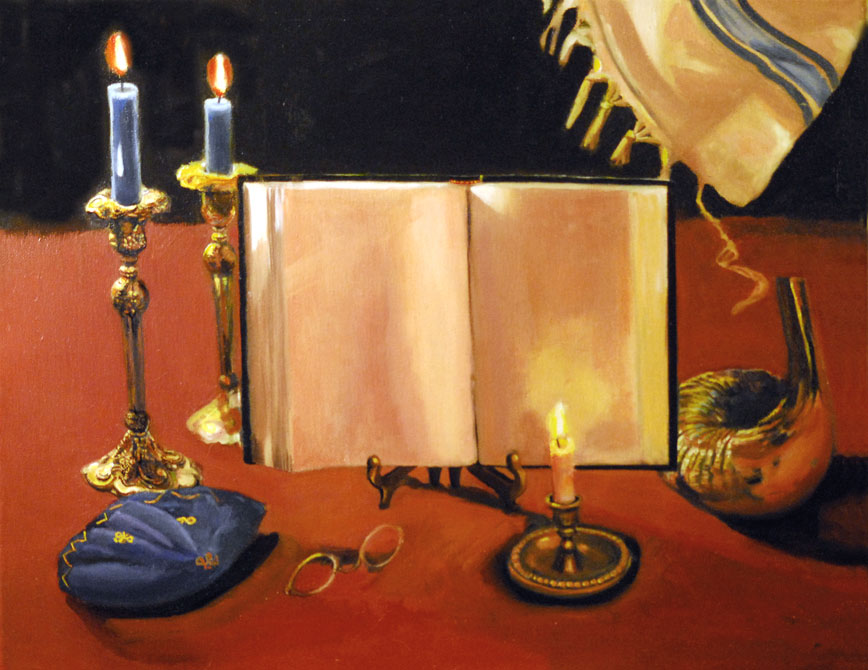Torah:
Torah (תּוֹרָה) is a Hebrew word meaning "teaching," "instruction," or "law". It refers primarily to the Five Books of Moses, also known as the Law of Moses (Torat Moshe תּוֹרַת־מֹשֶׁה) or the Pentateuch (Greek for "five containers," which refers to the scroll cases in which books were being kept). Other names include Hamisha Humshei Torah (חמשה חומשי תורה, "[the] five fifths/parts [of the] Torah") or simply the Humash (חומש "fifth"). A Sefer Torah is a formal written scroll of the five books, written by a Torah scribe under exceptionally strict requirements. The term is sometimes also used in the general sense to also include both Judaism's written law and oral law, encompassing the entire spectrum of authoritative Jewish religious teachings throughout history, including the Mishnah, the Talmud, the Midrash, and more.
The Torah is the first five books of the Tanakh or Hebrew Bible, and of the Old Testament of the Christian Bible. The five books, their names and pronunciations in the original Hebrew, are as follows:
Genesis (בראשית, Bereshit: "In the beginning...")
Exodus (שמות, Shemot: "Names")
Leviticus (ויקרא, Vayyiqra: "And he called...")
Numbers (במדבר, Bammidbar: "In the desert...")
Deuteronomy (דברים, Devarim: "Words", or "Discourses")
Written in Hebrew, the oldest Jewish language, the Torah is the central and most important document of Judaism revered by Jews through the ages, and very important to Christians. It is traditionally accepted as the literal word of God as told to Moses. For many, it is neither exactly history, nor theology, nor legal and ritual guide, but something beyond all three. It is the primary guide to the relationship between God and man, and the whole meaning and purpose of that relationship, a living document that unfolds over generations and millennia.
Tallit
The tallit (Modern Hebrew: טַלִּית) or tallet(h) (Sephardi Hebrew: טַלֵּית), also called tallis (Yiddish), is a prayer shawl that is worn during the morning Jewish services (the Shacharit prayers) in Judaism, during the Torah service, and on Yom Kippur and other holidays. It has special twined and knotted fringes known as tzitzit attached to its four corners. The tallit is sometimes also referred to as the arba kanfot, meaning the "four wings
the tallit is a special personal effect, generally used for many years or a lifetime and never discarded. Most Jewish men (and some women) own very few tallitot in their lifetimes. A threadbare tallit is treated with great respect, as if it had a mantle of holiness, acquired from years of use. Although there is no mandatory tradition, in Conservative, reform, and otherwise non-religious families a tallit, as well as tefillin, is likely to be given as a special gift, from father to son, from father-in-law to son-in-law, or from teacher to student. It might be purchased to mark a special occasion, such as a wedding, a bar/bat mitzvah, or a trip to Israel. When a man dies, it is traditional that he be buried dressed only in his kittel, with his tallit is draped over him. Otherwise, a religious Jew is required to have his own tallit
Shofar:
A shofar (IPA: [ˈʃoʊfər] (USA) or [ˈʃəʊfə(r)] (UK); Heb.: שופר) is a horn that is used as a musical instrument for Jewish religious purposes. It is intimately connected with both Rosh Hashanah and Yom Kippur. The shofar originated in Israel for Jewish callings.
The shofar is mentioned frequently in the Hebrew Bible, from Exodus to Zechariah, and throughout the Talmud and later rabbinic literature. It was the voice of a shofar, "exceeding loud," issuing from the thick cloud on Mount Sinai that made all the Israelites tremble in awe (Exodus 19, 20).
The shofar may be the horn of any kosher animal, except that of a cow or calf in deference to the biblical golden calf incident. Though there is nothing inherently wrong with using a cow's horns, it is not for the benefit to the Jewish people to remind God of such indiscretions when He is sitting in judgment.
The shofar is used mainly at Rosh Hashanah and Yom Kippur. It is blown in synagogues to mark the end of the fast at Yom Kippur, and blown at four particular places at Rosh Hashanah. Because of its inherent ties to the Days of Repentance and the inspiration that comes along with hearing its piercing clasts, the shofar is also blown after morning services for the entire month of Elul (excluding Shabbat and the morning before Rosh Hashanah), which is the last month in the year but the sixth of the Jewish months which are counted from Nisan. It is not blown on the last day of month, however, to mark the difference between the voluntary blasts of the month and the mandatory blasts of the holiday. Shofar blasts are also used during penitential rituals such as Yom Kippur Katan and optional prayer services called during times of communal distress. The exact modes of sounding can vary from location to location.
Kippah
A kippah (Hebrew: כִּפָּה, also kipah, kipa, kippa, plural kippot; Yiddish: יאַרמלקע, yarmlke, yarmulke, yarmulka, yarmelke, less commonly called kapel) is a thin, usually slightly-rounded cloth skullcap worn by observant Jews (normally men, but not always)
The word Yarmulke is a Yiddish word. It derives from the Polish word "jarmulka" meaning cap. The popular claim that it comes from an Aramaic phrase "Yari Malka", meaning "Fear of the King," is without
evidence, as is the claim of the Hebrew phrase "Ya'are me Elohim", "To tremble beneath the Lord". The interpretation that it is a tribute to God is emotionally resonant for Jews, which probably explains the popularity of this folk etymology.
In Hebrew, the word kippah means dome. It is fascinating to note that the ancient Gothic word kappel still exists in the Yiddish term today. The equivalent of the Hebrew word kippah is the French "calotte" and the Italian "calotta", meaning an architectural dome. |








